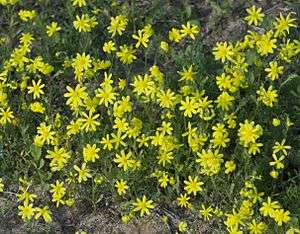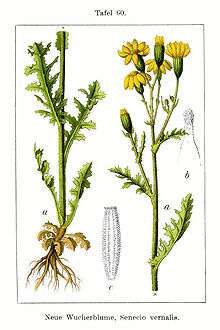Senecio vernalis
Senecio vernalis is one of the European species of Senecio, an annual that is also known as eastern groundsel. While it has been long classified as Senecio vernalis, this species has more recently been described as a subspecies of Senecio leucanthemifolius and is now included by some in that species.[4]
| Senecio vernalis | |
|---|---|
| Eastern groundsel | |
| Scientific classification | |
| Kingdom: | Plantae |
| Clade: | Tracheophytes |
| Clade: | Angiosperms |
| Clade: | Eudicots |
| Clade: | Asterids |
| Order: | Asterales |
| Family: | Asteraceae |
| Genus: | Senecio |
| Species: | S. vernalis |
| Binomial name | |
| Senecio vernalis | |
| Synonyms | |
|
Senecio euxinus Minderova[2][3] | |
Description
Eastern groundsel is a "lovely yellow-flowering weed found by the roadside and on the edges of fields"[5] that can be sometimes confused with S. eboracensis[6]
- Stems and leaves
- Leaves usually wavey, dissected, with lateral lobes that are about as long as width of central undivided portion, usually conspicuously covered with fine hairs. The edges are serrated. Leaves alternate one leaf per node along the stem.[6][7]
- Seeds
- The oldest collection of seeds recorded was 16 years; average germination change for these was from 100% to 82.5%, with a mean storage period 13 years.[8]
A Senecio and a diploid, Senecio vernalis is part of a species group along with S. flavus, S. gallicus, S. squalidus and S. glaucus who are widespread geographically and interesting for the study of genecology (the study of genetic differences in relation to the environment) and plant evolution.[9]
Common names

- English: eastern groundsel
- German: Frühlings-Greiskraut
- Estonian: Kevad-ristirohi
- Finnish: Kevätvillakko
- Dutch: Oostelijk kruiskruid
- Latvian: Pavasara krustaine
- Lithuanian: Pavasarinė žilė
- Hungarian: Tavaszi aggófű
- Croatian: Proljetni dragušac, Proljetni kostriš, Proljetni staračac
- French: Séneçon de printemps
- Slovene: Starček jarný
- Danish: Vår-Brandbæger
- Swedish: Vårkorsört
- Norwegian: Vårsvineblom
- Romanian: spălăcioasă
- Russian: Крестовник весенний
- Armenian: Հալևորուկ գարնանային
- Hebrew: סביון אביבי ,סַבְיוֹן אֲבִיבִי[4][1][7][10]
Distribution

Native:[1]
- Palearctic:
- Western Asia: Cyprus, Iran, Iraq, Israel, Jordan, Lebanon, Syria, Turkey
- Caucasus: Armenia, Azerbaijan, Georgia, Ciscaucasia, Dagestan
- Middle Asia: Turkmenistan
- Middle Europe: Austria, Hungary, Poland
- East Europe: Belarus, Croatia, Estonia, Crimea, Latvia, Lithuania, Ukraine
- Southeastern Europe: Albania, Bulgaria, Greece, Romania, Slovenia, Bosnia and Herzegovina, Montenegro, Serbia, Macedonia. Kosovo
Subspecies or varieties which are also synonyms
- Senecio leucanthemifolius subsp. vernalis (Waldst. & Kit.) Greuter[4]
- Misapplied names
-
- Senecio coronopifolius sec. Grossgejm, A. A.
- Senecio gallicus sec. Demiri, M.
- Senecio gallicus sec. Josifović, M. & al.
- Senecio gallicus sec. Hayek, A. von[4]
References
- "Senecio vernalis". Germplasm Resources Information Network (GRIN). Agricultural Research Service (ARS), United States Department of Agriculture (USDA). Retrieved 2008-04-09.
- Royal Botanic Gardens, Kew. "Flora Europaea Search Results". Seed Information Database. Board of Trustees of the Royal Botanic Gardens, Kew. Retrieved 2008-04-09.
- Tropicos. "Senecio vernalis Waldst. & Kit". Missouri Botanical Garden Press. Retrieved 2008-04-09.
- Botanic Garden and Botanical Museum Berlin-Dahlem. "Details for: Senecio leucanthemifolius subsp. vernalis". Euro+Med PlantBase. Freie Universität Berlin. Retrieved 2008-04-09.
- Rudolf Fritz Weiss, A. R. Meuss (2001). "Gynaecological Conditions and Diseases of the Breast". Weiss's Herbal Medicine. Thieme. pp. 372 pages. ISBN 978-1-58890-069-2. Retrieved 2008-04-09.
- LOWE, A. J.; R. J. ABBOTT (2003). "A new British species, Senecio eboracensis (Asteraceae), another hybrid derivative of S. vulgaris L. and S. squalidus L" (PDF). Watsonia. 24: 375–388. Archived from the original (PDF) on 2007-09-27. Retrieved 2008-04-09.
- Flora of Israel Online. "Senecio vernalis Waldst. & Kit". Hebrew University of Jerusalem. Retrieved 2008-04-09.
- Royal Botanic Gardens, Kew. "Search Results". Seed Information Database. Board of Trustees of the Royal Botanic Gardens, Kew. Retrieved 2008-04-09.
- Hollingsworth, Peter; Richard M. Bateman; Richard Gornall (1999). "Monophyly populations and species". Molecular Systematics and Plant Evolution. CRC Press. pp. 504 pages. ISBN 978-0-7484-0908-2. Retrieved 2008-04-23.
- "5 definiţii pentru spălăcioasă". DEX online (in Romanian). 2004-07-24. Retrieved 2008-04-10.
External links
![]()
![]()